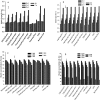Responses of AG1 and AG2 QTL introgression lines and seed pre-treatment on growth and physiological processes during anaerobic germination of rice under flooding
- PMID: 32576897
- PMCID: PMC7311552
- DOI: 10.1038/s41598-020-67240-x
Responses of AG1 and AG2 QTL introgression lines and seed pre-treatment on growth and physiological processes during anaerobic germination of rice under flooding
Abstract
Rice seeds germinating in flooded soils encounter hypoxia or even anoxia leading to poor seed germination and crop establishment. Introgression of AG1 and AG2 QTLs associated with tolerance of flooding during germination, together with seed pre-treatment via hydro-priming or presoaking can enhance germination and seedling growth in anaerobic soils. This study assessed the performance of elite lines incorporating AG1, AG2 and their combination when directly seeded in flooded soils using dry seeds. The QTLs were in the background of two popular varieties PSB Rc82 and Ciherang-Sub1, evaluated along with the donors Kho Hlan On (AG1) and Ma-Zhan Red (AG2) and recipient parents PSB Rc82 and Ciherang-Sub1. In one set of experiments conducted in the greenhouse, seedling emergence, growth, and carbohydrate mobilization from seeds were assessed. Metabolites associated with reactive oxygen species (ROS) scavenging including malondialdehyde (MDA) as a measure of lipid peroxidation, ascorbate, total phenolic concentration (TPC), and activities of ROS scavenging enzymes were quantified in seeds germinating under control (saturated) and flooded (10 cm) soils. In another set of experiments conducted in a natural field with 3-5 cm flooding depths, control and pretreated seeds of Ciherang-Sub1 introgression lines and checks were used. Flooding reduced seedling emergence of all genotypes, though emergence of AG1 + AG2 introgression lines was greater than the other AG lines. Soluble sugars increased, while starch concentration decreased gradually under flooding especially in the tolerant checks and in AG1 + AG2 introgression lines. Less lipid peroxidation and higher α-amylase activity, higher ascorbate (RAsA) and TPC were observed in the tolerant checks and in the AG1 + AG2 introgression lines. Lipid peroxidation correlated negatively with ascorbate, TPC, and with ROS scavengers. Seed hydro-priming or pre-soaking increased emergence by 7-10% over that of dry seeds. Introgression of AG2 and AG1 + AG2 QTLs with seed pretreatment showed 101-153% higher emergence over dry seeds of intolerant genotypes in the field. Lines carrying AG1 + AG2 QTLs showed higher α-amylase activity, leading to rapid starch degradation and increase in soluble sugars, ascorbate, and TPC, together leading to higher germination and seedling growth in flooded soils. Seed hydro-priming or pre-soaking for 24 h also improved traits associated with flooding tolerance. Combining tolerance with seed management could therefore, improve crop establishment in flooded soils and encourage large-scale adoption of direct seeded rice system.
Conflict of interest statement
The authors declare no competing interests.
Figures







References
-
- Yamauchi M, Aguilar A, Vaughan D, Seshu D. Rice (Oryza sativa L.) germplasm suitable for direct sowing under flooded soil surface. Euphytica. 1993;67(3):177–184. doi: 10.1007/BF00040619. - DOI
-
- Lal B, et al. Agronomic manipulations can enhance the productivity of anaerobic tolerant rice sown in flooded soils in rainfed areas. Field Crops Research. 2018;220:105–116. doi: 10.1016/j.fcr.2016.08.026. - DOI
-
- Setter T, et al. Physiology and genetics of submergence tolerance in rice. Annals of Botany, 79(suppl_1), 67-77. 10.1093/oxfordjournals.aob.a010308 (1997).
Publication types
MeSH terms
Substances
LinkOut - more resources
Full Text Sources
Miscellaneous

